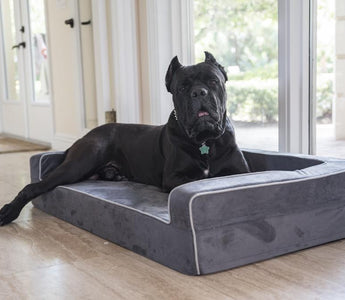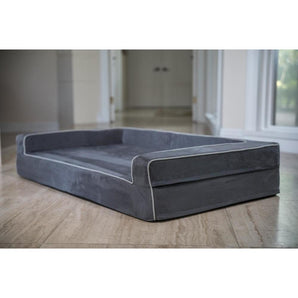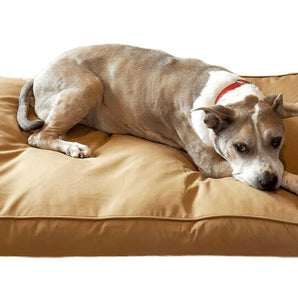No one wants to see their dog in pain. You feel helpless and don't know what to do. This is especially true when it comes to hip dysplasia in dogs.
Most large breed dog owners have heard of hip dysplasia, but don't know anything specific. If not treated properly, this scary condition can have negative effects on your pet's happiness and longevity.
It's true that large dogs are much more likely to develop this disease than small dogs, but it's still possible for them to be affected. All dog owners should know the signs, symptoms, and treatment options for hip dysplasia.
What is Hip Dysplasia?
Canine hip dysplasia (CHD), is a common skeletal disease often found in large dog breeds. It's also found in smaller breeds, and even puppies as young as three months can receive a diagnosis.
When working properly, the hip joint functions as a ball and socket. If you're unfamiliar with what this means, it's just a way of saying that a rounded part of one bone moves in the concave surface of the connecting bone.
This type of joint allows the most freedom and mobility of any other joint connection.
Hip dysplasia occurs when there's a problem with the hip joint connection. In some cases, some dogs' ball and socket hip joints don't fit together right and the bones grind against each other incorrectly.
It can be very painful for your dog. Over time, this causes the bones to deteriorate, and eventually, the affected hip joint won't be able to function at all.
Genetics and Hip Dysplasia
Genetics plays a large role in hip dysplasia. It's common to be passed down from one generation to the next. A dog with hip dysplasia has about a 25 percent chance of passing it down to their puppies.
Even though it's a genetic disease, environmental factors can cause it to worsen. A rapid growth rate, damaging exercise, and your dog's diet can cause this genetic condition to worsen.
Most Affected Dog Breeds

All dogs are at risk, but canine hip dysplasia shows up more often in certain breeds. Because it's a genetic condition, it gets passed down from adult dogs to their offspring.
Larger and giant breed dogs are more likely to develop the condition than smaller dogs. This is because of their different growth rates.
When buying from a breeder, you can ask what screening tests they've performed. There are tests available that can predict whether or not a dog will develop hip dysplasia.
Since some large dog breeds are at a higher risk than others, having a breeder run some tests will help you know what to expect. They should also show you the dog's family history.
These are a few of the most affected dog breeds.
- Great Danes
- Saint Bernards
- Boxers
- Golden Retrievers
- Australian Shepards
- Mastiffs
- German Shepards
- Labradors
- Rottweilers
- Pitbulls
The Best Dog Beds for Hip Dysplasia (2021)
Types of Hip Dysplasia
Most times this developmental disease doesn't show signs until a dog is well into adulthood. That doesn't mean it can't affect puppies.
Many experts believe that there are two different types of hip dysplasia. They divided them into two separate categories because the symptoms can be very different.
Knowing what to look for at what times in your dog's life can make a huge difference.
Juvenile hip dysplasia occurs in dogs younger than 19 months. A puppy with a genetic predisposition for hip dysplasia has functioning hip joints when born.
Their hips start to change a few weeks after birth and a visible limp or discomfort may appear after a few months.
Mature hip dysplasia is present in affected adult dogs. It's possible they went undiagnosed when they were a puppy and now their disease has worsened. They could have developed the condition from situational factors.
Causes of Hip Dysplasia
There are a few causes of hip dysplasia in dogs. One is genetics. Most cases of hip dysplasia were passed down from the parents.
Size also has an impact on the ball and socket hip joints, making this disease much more common in larger breeds.
Nutrition and weight play a role as well. Obesity puts unneeded stress on your dog's joints and too little or too much exercise can hurt them.
Different breeds need varying levels of exercise.
A rapid growth rate can negatively impact your dog's hips. Puppies grow fast and need to eat a lot, but feeding them too much can hurt their development.
The bones and soft tissue structure should grow in tandem. This creates a stable joint. When the bones grow faster than the soft tissue, it results in a wobbly connection that over time can become osteoporosis.
What is Osteoporosis?
Microscopes reveal that healthy bones have a honeycomb appearance. This is because of small holes throughout the structure. In bones with osteoporosis, these holes grow larger.
When the holes become too big this can lead to a multitude of health problems. Weaker bones are easier to break, hurt more, and drastically limit mobility.
Dogs suffering from hip dysplasia have a high risk of developing osteoporosis.
Prevention
It is impossible to prevent every dog from developing hip dysplasia. But, if you see the symptoms of hip dysplasia in your dog soon enough, there are a few actions you can take.
These precautions will ease their pain and hopefully, prevent the disease from spreading.
Supplementing their Diet

There are many joint supplement options out there that work by soothing stiff joints. An anti-inflammation supplement is standard.
Some supplements keep joint fluid healthy which makes movement easier. Others help cartilage stay strong and smooth.
Glucosamine is a common supplement for dogs with arthritis. They are safe to use over a long period of time and tend to work well as a joint supplement.
Researchers aren't sure how well glucosamine works as a preventative, but it can relieve some of your dog's pain and strengthen their bones.
Smaller breed dogs are at a much lower risk. It may not be worthwhile to use this supplement unless you have a diagnosis. If your dog is a large breed and has a family history, glucosamine could help them.
In addition to glucosamine, supplements generally have these ingredients.
- Omega3
- Vitamin C
- Vitamin E
- Chondroitin
- Turmeric
- Hyaluronic acid (present in joint fluid)
Don't be too concerned with side effects. Studies have shown that most supplements are safe for dogs to take over a long period of time. You can consult with your vet if you have additional concerns.
Diet and Exercise
Dogs with a healthy physique are less likely to develop joint problems. Every breed has different weight and exercise needs so consult your vet to find the best health plan.
Most owners don't worry about an overweight puppy because they're growing. Keeping young dogs at optimal weight will help their bones grow in tandem with the surrounding tissue.
Over-exercising can also be detrimental to the joints of a growing puppy. Making sure your dog receives adequate food and activity is important, but be cautious about overdoing it.
X-rays and Screening Options
For breeders, it's worthwhile to set aside money for routine screenings of their larger breeds. This helps them make an informed decision about which dogs to select for breeding.
Wait to Neuter Your Puppy
Research shows that delaying neutering your dog for the first year can be beneficial. After neutering, a lot of dogs go through a rapid growth spurt. Putting of this procedure is mainly recommended for breeds that are at high risk.
Diagnosing Hip Dysplasia in Dogs
You should be bringing your dog to the vet for regular check-ups. Part of a routine vet visit will be looking for some of the signs of hip dysplasia.
Don't worry If you've recently adopted your dog and don't know their medical history. The shelter or breeder will give any health information they have to you.
Any signs or symptoms of hip dysplasia are most likely noted.
Your vet will conduct a physical examination. If they find anything irregular, they will ask you about the common signs of hip dysplasia in dogs.
Signs of Juvenile Hip Dysplasia
These symptoms may be harder to spot in dogs as opposed to puppies. With puppies, the pain is sudden and easier for them to notice. An adult dog has had the condition develop over time and might be more subtle with coping.
- Bunny hopping
- Joint looseness
- Strange positions when sitting
- Difficulty with stairs
- Reluctance to exercise
- Limping
- Chronic lameness
- Slow to stand up
- Stiffness
- Lethargic
- Muscle loss in hind legs
Signs of Mature Hip Dysplasia
Seeing a few of these signs once or twice is no cause for concern. If your dog displays symptoms most of the time, that's a sign that they need to go to the vet.
- Unusual levels of inactivity
- Limping
- General problems with hind legs
- Sleeping more often
- Joint looseness
- Swaying when walking
What to Expect at the Vet
Bringing your dog to the vet can be stressful for even a routine checkup. Knowing what to expect should help to settle some of your nerves.
The vet will begin with a routine physical test.
Starting with a joint laxity examination, the vet will manipulate the back legs to search for signs of pain, lack of mobility, detached joints, or any unusual looseness in the hip joints.
Depending on the physical examination your vet may want to run a few lab tests. This consists of a urinalysis, a blood test to check for inflammation, and an electrolyte panel.
Be prepared to answer any questions they may have about your pet's history. If hip dysplasia runs in their bloodline, bring the necessary paperwork to show your vet.
X-ray Testing
Any dog that shows symptoms or has a history of hip dysplasia in their family will need an X-ray.
A normal X-ray should provide most of the information your vet needs to diagnose your dog. Any abnormal joints will be visible. For more specific information, many breeding organizations use advanced X-rays.
They use these X-rays to help them decide which dogs to breed in the future. They also improve experts' ability to predict which dogs will develop hip dysplasia later in life.
The Orthopedic Foundation for Animals (OFA) is a very common test done in the United States. Your dog must be at least two years old and they won't receive sedation.
No special certification is required for a vet to run this test. While the OFA screening can tell you a lot about the likelihood of a dog developing hip dysplasia, it is not as accurate as the PennHIP test.
The PennHIP screening was also created to test for hip abnormalities. It predicts the chances of hip dysplasia occurring or passing down to the offspring.
Both tests look for any signs of joint weakness and hip abnormalities. They search for other factors to get all possible information. This helps breeders make the best choice for deciding which dogs to breed.
It's possible to perform the PennHIP test on puppies that are four months old at the earliest. The sooner owners know if their pet has hip dysplasia or is at high risk to develop it the better they can prepare.
Any dog that gets the PennHIP screening will receive sedation. It requires your vet to go through specific training to be allowed to run the test. When it comes to cost, the PennHIP is more expensive than the OFA screening.
Both of the screening tests have their benefits, but studies show the PennHIP to be more accurate. Despite this, the OFA is the standard test used in the United States.
You aren't required to run these tests, but they can provide useful information. Knowing your dog has sensitive hips that might worsen over time, can help you better care for them.
How to Treat Hip Dysplasia in Dogs
Hip dysplasia is a progressive condition. It will get more severe over time with the end result will being a decline in health and loss of function.
New advancements are being made every day, so this may not be true in the near future. For now, there are some treatment options currently available. The impact will vary on a case-by-case basis.
Effective treatments will focus on pain management above all else. Even though the disease itself is progressive, you can stop it from developing. Arthritis and osteoporosis often originate from hip dysplasia.
Juvenile Hip Dysplasia
The only exception to the rule is Juvenile hip dysplasia. It's possible that with the right treatment, the joint will stabilize as the puppy matures.
As soon as you suspect your young dog may be suffering, bring them to the vet. If your dog has juvenile hip dysplasia, you can work out a treatment plan.
A standard plan will include moderate exercise, physical therapy, and pain management.
Medications and Holistic Options

Arthritis and hip dysplasia share many similar signs and symptoms. Because of this, many of the medications meant to treat one will work for the other. Oral joint support chews are an easy way to ease the pain.
Anti-inflammatory medications work well for many adult dogs. When choosing a medication with the guidance of your vet, you should look for supplements that reduce swelling and improve joint strength.
Nonsteroidal anti-inflammatory drugs (NSAIDs) are reliable for treating hip dysplasia. Studies show that they are effective for treating pain and osteoporosis.
Analgesics, when used with NSAIDs, offer additional pain relief. Other medications that work in a similar way as analgesics are tramadol and codeine.
Some herbs can also alleviate pain.
Dandelion and nettle help repair joints. Licorice and yucca have anti-inflammatory qualities. Alfalfa relieves pain. Rosemary and Hawthorne will improve blood circulation.
With proper medication and care it's very common for dogs with hip dysplasia to live a long and happy life. Scientific advancements make it possible for them to be pain-free.
Exercise and Physical Therapy
To prevent further degeneration of the joints, varied exercise is highly recommended. Talk with a professional to create a workout plan. Too much exercise can cause joint and muscle damage.
The best workout plans will help your dog maintain a healthy weight. They involve low to moderate impact exercises.
Surgery
If caught early enough, surgery is a valid treatment option. For dogs under 1 year, there are a few choices. For older dogs, surgery is still a possibility and there's a high rate of recovery.
The only downsides to surgery are the aftercare and overall expense.
After-care is just as vital to your dogs' healing as the surgery itself. It can be the difference between a full recovery and permanent damage. Always follow all after-care instructions rigorously!
The cost of the surgery is difficult to factor in when deciding if it's a valid option. It may save money down the road if you don't have to constantly buy medications and pay for physical therapy. For some, this is a cheaper choice.
A few factors that will impact the cost of the procedure are your dog's breed, age, and health history. The type of procedure, whether it's performed by a clinic or private practice will impact the price.
Ranges for hip dysplasia surgeries are large. Insurance claims can be between $1,500-$7,000. There are a lot of variables that only you can calculate.
Even though it can come with a scary price tag, surgery has high rates of success. Most of the procedures listed below have at least an 80 percent success rate. It's up to you as the owner to decide what the best treatment is.
Juvenile Pubic Symphysiodesis
Juvenile Pubic Symphysiodesis has a high success rate. It has to be performed when your dog is around four to five months old. This minimally invasive procedure can help repair the hip joint and prevent arthritis.
Your puppy will be under the effects of general anesthesia. This will put them in an unconscious state. It's done to prevent pain and to keep them stationary.
There are some risks involved with anesthesia. Side effects can range anywhere from swelling and irritation to anaphylactic shock and death. If your dog has a bad history with anesthesia your surgeon needs to know.
If your dog's never been under anesthesia, you can run tests to determine if any underlying conditions will impact your dog's health.
Chemistry tests to evaluate the liver, sugar levels, and kidney can be administered.
A complete blood count test checks for blood-related problems.
An electrolyte test will make sure your dog is properly hydrated. It looks for an electrolyte imbalance.
With a professional's input, you can decide whether or not anesthesia is worth the risk. There are precautions the vet will have you take in preparation to minimize the anesthesia's effects.
Fasting before the surgery is common. This is to prevent your dog from vomiting. Excessive vomiting can lead to a condition called aspiration pneumonia. It could be fatal.
Your dog will be monitored throughout the entire procedure.
Once your dog is unconscious, the surgeon will make a small incision between the hind legs to reveal the pubic bone and pelvis. To stop the pubis bone from growing, it will be cauterized.
When successful, this procedure stops the center of the pelvis from growing and the rest of the pelvis continues to develop. It causes the hip socket to rotate and cover more of the ball joint. This means a stronger hip.
Aftercare is important after any surgery. Your surgeon will give you discharge instructions that are non-negotiable.
Limit activity for about two weeks after the procedure. Examine the incision scar for any signs of infection daily. Use any pain medications prescribed.
Double or Triple Pelvic Osteotomy
Double or Triple Pelvic Osteotomy is for puppies between the ages of six to 12 months that have hip dysplasia, but not arthritis. Also done under anesthesia, it has a 90 percent success rate.
During this operation, the surgeon will rotate the pelvis to align it with the hip. After the surgeon cuts the pelvis, screws hold it together.
Potential side effects include infection, urinary problems, and sciatic nerve pain. These usually occur because proper aftercare procedure was not followed.
For two months after surgery, limit your dog's exercise. Too much activity will cause the plates and screws that are holding the bone in place to loosen. In extreme cases, they even break.
Medications will be prescribed after the surgery. Make sure any bandages or coverings are clean and dry. For two weeks your dog needs to wear a sling to protect from falling.
You will have follow-up appointments scheduled. Six weeks after surgery you will have your second follow-up appointment. Your vet will run X-rays to measure improvements. In most cases, the healing process takes three to four months.
Femoral Head Ostectomy
Femoral Head Ostectomy is very affordable compared with other surgical options. It's recommended for dogs over 12 months who weigh less than 40 pounds. Young and mature dogs can benefit from this treatment.
In preparation for the surgery, your dog's hind leg hairs will be clipped. They will be under general anesthesia.
The femoral head is completely removed during the procedure. This eliminates the source of pain which is bone rubbing on bone.
After surgery, the joint will become stabile by scarring which makes a false joint. The scarring is between the acetabulum and femur providing a cushion.
As with all surgeries, aftercare is just as important, if not more so, than the actual procedure. For a full recovery, your dog will have to exercise. Physical therapy will most likely include swimming to increase the range of motion.
Follow all instructions regarding medications. Never stop before you are told to by a professional. Dogs cannot express pain the same way humans can. Even if they look fine, they still need the correct doses of pain medication.
Recovery varies based on your dog's age, but after two to three months they should be fully recovered.
Total Hip Replacement
Total Hip Replacement is for large dog breeds. Specifically, those that have seen no improvement with other non-surgical treatments. There is a high chance of infection, but it has a 90 percent success rate.
Total hip replacement is a salvage procedure. It's reserved for large mature dogs in debilitating pain. The ones who have not responded to other therapies.
To prepare your dog beforehand, you should bathe and dry them. Make sure they stay as clean as possible. There is a high risk of infection with this surgery so you need to be careful. You also need to shave their leg.
General anesthesia will be used. The surgeon will make an incision at the hip area and remove the ball and socket. To replace the bones, a plastic cup connects to the acetabulum, and a steel implant is placed in the femur.
You will have to stay in the hospital for a night or two after the surgery. Once home, give your dog the prescribed medications. This will include anti-inflammatories and other oral pain prescriptions. Use them until gone.
Look for signs of infection near the incision. Common signs of infection are redness, heat, and swelling. A few days after surgery, your dog should be able to put weight on its hind legs.
For two months you will have to severely limit exercise. Only take your dog outside when needed. Because of the long sedentary period, your dog will lose muscle mass. Physical therapy helps remedy this.
Dog Hip Braces
An important part of recovery from surgery is not putting pressure on the hip joint. Dog hip braces allow mobility without jeopardizing recovery. Not all dogs are eligible for surgery, for them, hip braces are a pain management option.
An orthopedic brace can help puppies who are showing signs of developing hip dysplasia. They provide support and stability to lessen the impact on the hip joint.
Recent Treatment Breakthroughs
These are not available for public use due to further testing being needed. They show that new treatments may not be far from grasp.
Researchers found that using platelet-rich plasma, in addition to physical therapy, helped increase limb function.
Stem cells combined with hyaluronic acid seem to improve hip joint range of motion.
For both experiments, no negative side effects were noted. A small number of dogs were tested. More study is needed with larger sample sizes.
Living with Hip Dysplasia
In the future, there may be more treatment options for hip dysplasia. For now, odds are your dog can still live a long and happy life with this disease.
Maintaining a healthy weight will reduce the impact on your dog's hip joint. Physical therapy can help you create a workout plan and your vet can give you some diet suggestions. Do this to promote mobility and muscle strength.
Acupuncture helps some dogs manage their pain when used with physical therapy.
Temperature affects your dog's hip joint. Avoiding cold weather will help them.
Find a dry warm spot for them to sleep. Learn how to keep your dog comfortable in colder weather. Keeping them off the ground, buying a space heater, and piling them under blankets are a great start.
Putting down rugs or carpets over slippery floors prevents them from falling. Putting in a ramp so your dog doesn't have to walk upstairs makes the transition easier.
Life Expectancy
Hip dysplasia should not affect your dog's life expectancy. You will have to watch their weight and joint flexibility more often. Remaining active can be hard if it is painful for your dog.
It's a scary, but manageable condition. There are many dogs diagnosed with it that live relatively pain-free lives.
Schedule consistent vet appointments. Your dog should take a trip to the vet every six months. A physical check-up will ensure that you're providing the best treatment and care possible.
What Can You Do?
Take your furry friend to the vet! Routine appointments can save your dog from a lot of pain.
Do more research! There's so much more information that we didn't cover here. Branch out and find out what you can about this common disease.
Take care of your dog! If your dog has hip dysplasia, do everything you can. Surgery is expensive and not every dog is eligible. There is a myriad of other treatments available that are worth trying.
Hip dysplasia in dogs is scary and painful. You may feel limited by treatments options and invasive surgeries, but there are courses of action you can take. Every dog deserves a long and happy life.






